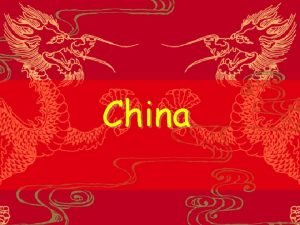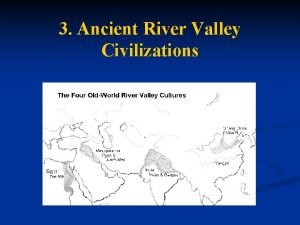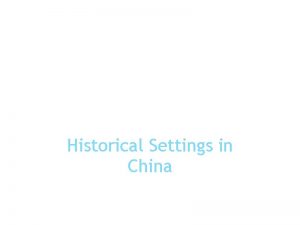Ancient China Main Idea The ancient Chinese developed














- Slides: 14

Ancient China Main Idea: The ancient Chinese developed a civilization that has lasted longer then any other on Earth. Why It Matters Now: China’s very long and relatively stable existence has helped it to become one of the most powerful countries in the world

Foundations of Chinese Civilization The Chinese have the longest lasting culture in the world. Early as 5000 B. C. people lived in the Fertile River Valley. 1700 B. C. invaders called the Shang entered their valley. The Shang established Chinas’ first permanent organized civilization.

Dynasties Dynasties – Families of rulers. Dynasties rose and fall in succession some lasting only 15 years other continuing for hundreds of years. 1211: Mongols invade China. They’re led by Genghis Khan 1279: Kublai Khan (GK’s grandson) conquered China’s Song Dynasty. He replaced it with the Yuan Dynasty.

Dynasties Dates Shang 1700 s – 1122 B. C. Zhou 1122 – 221 B. C. Qin 221 – 206 B. C. Han 206 B. C. - A. D. 220 Sui A. D. 581 – 618 Tang A. D. 618 – 907 Song A. D. 960 – 1279 Yuan A. D. 1279 – 1368 Ming A. D. 1368 – 1644 Qing A. D. 1644 – 1911

Religion and Philosophy Toward end of Zhou Dynasty a man named Kongfuzi - later called Confucius by Europeans developed a new philosophy Confucius taught the importance of moral character of individuals taking responsibility for th state of their society 121 B. C. Han emperor Wudi established Confucianism as the official philosophy guiding th Chinese bureaucracy. Bureaucracy-the administration of a governmen through departments called bureaus.

Taoism was developed in the 500 s B. C. by Lao Tzu, who wrote the main Taoist book – the Taoist Ching. A force that guides the universe, though cannot be seen or named. He called it the Tao which means “way of Nature.

Buddhism In China A. D. 200 s Buddhism started spreading in China through traders from india and other areas in Asia. Buddhism did not replace Confucianism or Taoism in China. The Chinese belief system now includes elements of all three philosophies.

Achievements of the Dynasties 2700 B. C. the Chinese invented silk cloth and a new system of writing. First two centuries A. D. , the Chinese invented paper and a type of pottery called porcelain. A. D. 1200 s, Chinese navigators began using compasses. Chinese systems first used pictographs to represent objects or ideas.

Ancient Japan Main Idea: For hundreds of years Japan developed it’s unique culture with influence from only it’s closest neighbors, China and Korea. Why It Maters Now: Japan continues to follow an independent path in world affairs.

Early Japan 10, 000 to 300 B. C. , hunters, gatherers, and skilled fishermen lived along Japan’s eastern coast. Toward the end of this period, they began practicing the religion Shinto , which means “ the way of the gods” Shinto teaches that supernatural beings called Kami live in all objects and forces of nature.

Clans Early Japanese lived in kingdoms organized around clans. Clan – a group of families who trace their descent from a common ancestor. Yamato clan emerged as the most powerful.

Outside Influences Japan began using new ideas and practices from it’s neighbors Korea and China In the A. D. 500 s, China began to influence Japan’s culture directly as well Prince Shotoku Taishi became a Buddhist and a student of Chinese literature and culture.

The Heian Age A. D. 794, the emperor Kammu built a new capital called Heian-Kyu. The period from that year to 1185 is called the Heian Age. It’s considered Japan’s golden age. Buddhism became a national religion.

The Samurai Samurai-warriors who protect people. 1192 in Kamakura, the clan’s leader, Yoritomo, established a new kind of warrior government called a shogunate. Shogun - emperor’s chief. Lady Murasaki wrote the world’s first novel called The Tale of Genji. One branch of Buddhism, called Zen was the most influential in Japan.
 Whats a supporting idea
Whats a supporting idea How to identify central idea
How to identify central idea What is controlling idea
What is controlling idea What is the difference between topic and theme
What is the difference between topic and theme Example of irrelevant
Example of irrelevant Ancient india vs ancient china
Ancient india vs ancient china Anglo chinese school primary
Anglo chinese school primary The ming dynasty ended rule of china.
The ming dynasty ended rule of china. 969
969 Hekla mid atlantic divergent
Hekla mid atlantic divergent Paraguay: packing -news -china -chinese -alibaba -amazon
Paraguay: packing -news -china -chinese -alibaba -amazon Grain cleaning plant
Grain cleaning plant 221 ad
221 ad Ancient chinese matches
Ancient chinese matches 4 river valley civilizations
4 river valley civilizations


























